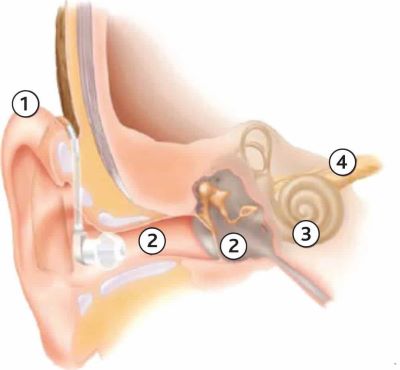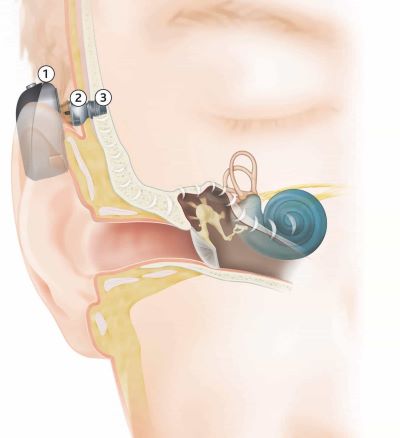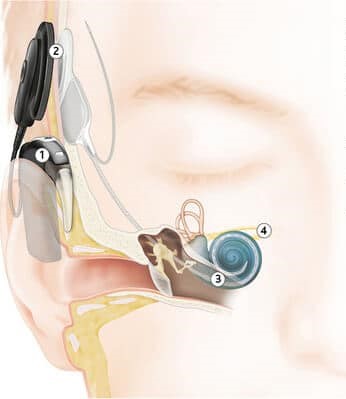Children with a permanent hearing loss may be fitted with hearing aids.
There are 3 types of aids:
- behind the ear (BTE) or air conduction hearing aids
- bone conduction or bone anchored hearing aids (BCHA/BAHA)
- cochlear implants.
Hearing aids
A hearing aid is a small electronic device that can be worn in or behind your ear and makes sounds louder. The microphone receives sounds, and the amplifier makes them louder and sends them to your child’s ear through a speaker.
Your child’s hearing aids will be programmed by an audiologist to match their type of hearing loss.
Australian Hearing can provide hearing aids and other devices at no cost, other than a low annual maintenance fee that covers batteries and repairs.

Image courtesy of Cochlear Limited © 2017 All rights reserved.
How a hearing aid works
- The microphone in the hearing aid picks up sound and sends it to the amplifier where it makes it louder.
- These impulses are sent to the brain where they are perceived as sound.
- Motion transferred to the cochlea fluids is converted into electrical impulses by tiny hair cells inside the cochlea.
- The receiver of the hearing aid sends the amplified sound down the ear canal, causing the eardrum and the middle ear bones to vibrate.
Bone conductors
Bone conductors are bone conduction or bone anchored hearing aids (BCHA/BAHA).

Image courtesy of Cochlear Limited © 2017 All rights reserved.
Baha Connect System
The system sends sound signals via bone conduction, naturally stimulating the ear. The system consists of:
- Sound processor that detects sound and transforms it into vibrations.
- Abutment that connects the sound processor to the implant.
- Implant that transfers sound vibrations directly to the ear.
Cochlear implants
A cochlear implant is a surgically implanted device, which can provide useful hearing sensations by sending electrical signals to the nerve endings in the inner ear (called the “cochlea”).
A cochlear implant goes around the part of the ear that isn’t working and electrically stimulates the hearing nerve directly.
Your child will be assessed at a cochlear implant clinic to determine if an implant is suitable for their hearing loss.
The surgery is done by a cochlear implant surgeon. The surgery may only take an hour, but your child will usually need to stay in hospital overnight.

Image courtesy of Cochlear Limited © 2017 All rights reserved.
Nucleus Cochlear Implant
This implant bypasses parts of the ear that no longer work properly by sending signals directly to the hearing nerve.
- Microphones on the sound processor pick up sounds and the processor then convert them into digital information.
- This information is transferred through the coil to the implant just under the skin.
- The implant sends electrical signals down the electrode into the cochlea.
- The hearing nerve fibres in the cochlea pick up the signals and send them to the brain, giving the sensation of sound.
Developed by the Queensland Hearing Loss Family Support Service. We acknowledge the input of consumers and carers.
Disclaimer: This information has been produced by healthcare professionals as a guideline only and is intended to support, not replace, discussion with your child’s doctor or healthcare professionals. Information is updated regularly, so please check you are referring to the most recent version. Seek medical advice, as appropriate, for concerns regarding your child’s health.